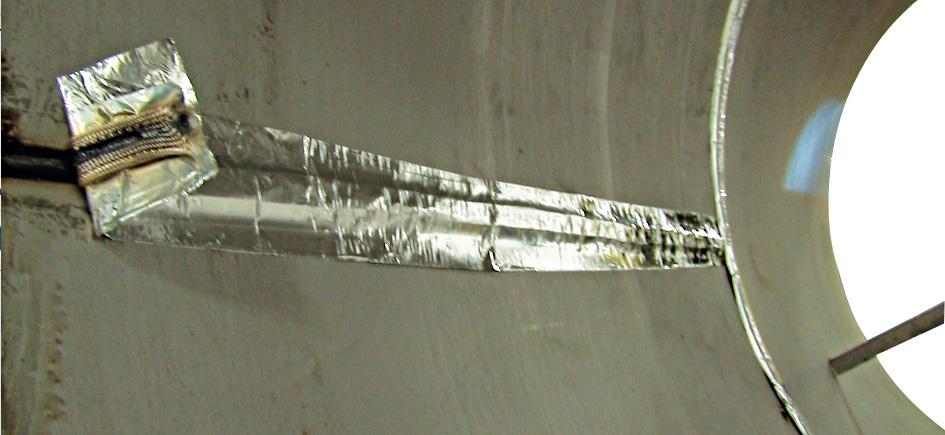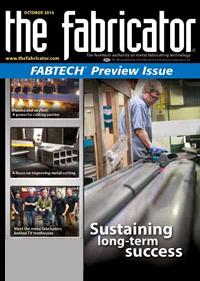- FMA
- The Fabricator
- FABTECH
- Canadian Metalworking
Categories
- Additive Manufacturing
- Aluminum Welding
- Arc Welding
- Assembly and Joining
- Automation and Robotics
- Bending and Forming
- Consumables
- Cutting and Weld Prep
- Electric Vehicles
- En Español
- Finishing
- Hydroforming
- Laser Cutting
- Laser Welding
- Machining
- Manufacturing Software
- Materials Handling
- Metals/Materials
- Oxyfuel Cutting
- Plasma Cutting
- Power Tools
- Punching and Other Holemaking
- Roll Forming
- Safety
- Sawing
- Shearing
- Shop Management
- Testing and Measuring
- Tube and Pipe Fabrication
- Tube and Pipe Production
- Waterjet Cutting
Industry Directory
Webcasts
Podcasts
FAB 40
Advertise
Subscribe
Account Login
Search
Fiberglass tape that has your [weld’s] back
High- and low-amperage capabilities increase flexibility
- By Amanda Carlson
- October 22, 2014
- Article
- Cutting and Weld Prep
To make welds with complete joint penetration, the welder has two choices: He can prepare and weld the joint on both sides, or he can attempt a one-sided weld. One-sided welds are preferred as they save time, but they are difficult to accomplish.
One way to achieve one-sided welds is using a weld backing system, which provides the support necessary for the molten root pass and saves the welder time by allowing him or her to weld only from one side. Weld backing also helps trap inert gas on the opposite side of the welding torch. The presence of this gas helps to create an optimal weld pool to ensure proper side-wall fusion, which helps decrease the presence of weld defects.
As John Bowes, director of welding at Aquasol Corp., North Tonawanda, N.Y., explained, “If you put air into water you have a series of bubbles. In welding, you’re trying to form a solid mass. If you have bubbles, they will weaken the solid mass. That’s what we call porosity, which we are trying to do away with.”
Though there are advantages and disadvantages to traditional weld backing methods, Aquasol has introduced a new method that it says is flexible for use on a variety of weldments, including curved; is easy to use; and is reliable.
Customers and potential customers approached Aquasol with a need: a weld backing system that could work in multiple applications and orientations, that was cost-effective, that was safe and easy to use, and could be removed easily.
Leaning on its expertise in the water-soluble paper and tape product lines, Aquasol developed a weld backing product made of fiberglass that provides flexibility in flat, curved, and rounded applications. From start to finish it took approximately a year to develop, said Jonathon Gondek, product engineer.
The first version, the Fiback® 600 AMP, is compatible with dense materials like stainless and duplex stainless steel, and for welding applications in which higher amperages and fast arc travel speed are necessary. Cheryl Gondek, vice president of sales and marketing, said the product has found a niche in the welding of tanks used in the hydrofracturing industry.
“The Fiback tape allows operators to run a continuous bead. If the operator were using an alternative backing method, they would have little stress points in the weld. They like the fact that they can weld continuously on very large tanks with one roll of the tape.”
Bowes added that a stainless steel fabricating company in Pennsylvania relies on the product not only to protect the back side of their welds, but also to speed up the overall welding process by eliminating the need to use a secondary purge gas through the back side of the weld.
According to Alex Grenning, product engineer, “Shipbuilding is a big industry for this product. It makes sense if you think about these applications. Some of the more established weld backing methods are generally better-suited for flat-plane welding. But we’re talking about tanks, shipbuilding, and applications where welding is taking place on different shapes of curves. The Fiback has the flexibility to conform to those alternative shapes. That really is the huge advantage to the product.”
New this year is the Fiback 200 AMP backing tape, suitable for thinner materials welded at lower amperages and arc travel speeds. The new amperage is the result of market research paired with customer feedback, Jonathon Gondek said.
“Certain customers came to us and said the 600 AMP was a little overkill. We felt it was a good idea to make multiple varieties because people don’t always need the higher-amperage product.”
The 200 AMP is geared toward fabrication shops, general maintenance, pressure vessel and aircraft fabrication and maintenance, and in most shops where gas metal arc welding (GMAW) and gas tungsten arc welding (GTAW) are performed.
As to whether more amperage options will become available in the future, Bowes said that it depends on the ever-changing and adapting needs of the end user.“It’s ongoing. The ideas that we are getting based on the feedback from our clients as they approach us with questions enables us to determine what the market needs,” Bowes said.
About the Author

Amanda Carlson
2135 Point Blvd
Elgin, IL 60123
815-227-8260
Amanda Carlson was named as the editor for The WELDER in January 2017. She is responsible for coordinating and writing or editing all of the magazine’s editorial content. Before joining The WELDER, Amanda was a news editor for two years, coordinating and editing all product and industry news items for several publications and thefabricator.com.
Related Companies
subscribe now

The Fabricator is North America's leading magazine for the metal forming and fabricating industry. The magazine delivers the news, technical articles, and case histories that enable fabricators to do their jobs more efficiently. The Fabricator has served the industry since 1970.
start your free subscription- Stay connected from anywhere

Easily access valuable industry resources now with full access to the digital edition of The Fabricator.

Easily access valuable industry resources now with full access to the digital edition of The Welder.

Easily access valuable industry resources now with full access to the digital edition of The Tube and Pipe Journal.
- Podcasting
- Podcast:
- The Fabricator Podcast
- Published:
- 04/16/2024
- Running Time:
- 63:29
In this episode of The Fabricator Podcast, Caleb Chamberlain, co-founder and CEO of OSH Cut, discusses his company’s...
- Industry Events
16th Annual Safety Conference
- April 30 - May 1, 2024
- Elgin,
Pipe and Tube Conference
- May 21 - 22, 2024
- Omaha, NE
World-Class Roll Forming Workshop
- June 5 - 6, 2024
- Louisville, KY
Advanced Laser Application Workshop
- June 25 - 27, 2024
- Novi, MI
































